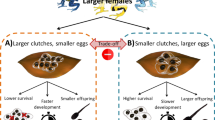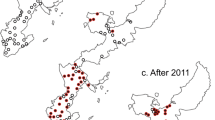Abstract
Because male giant water bugs in the subfamily Belostomatinae provide parental care by brooding eggs on their back, an accurate assessment can be made of both the actual and potential reproductive capacity of males. Two operational sex-ratio (OSR) indices were developed and empirically measured for a population of giant water bug, Abedus indentatus,in California. One index was based on reproductive rates measured in the laboratory; the other index was based on reproductive resources observed in the field. Both OSR indices suggest that the operational sex ratio fluctuates between maleskewed ratios in the summer and femaleskewed ratios in the winter. This pattern appears to be the consequence of two factors. First, the adult sex ratio is significantly female biased. Second, although males can outreproduce females at high ambient temperatures, the reverse is true at low temperatures. Possible reasons for the female-skewed adult sex ratio are examined, including differential recruitment, differential mortality, and sampling bias.
Similar content being viewed by others
References
Bateman, A. J. (1948). Intrasexual selection inDrosphilia.Heredity 2: 349–368.
Baylis, J. R. (1981). The evolution of parental care in fishes, with reference to Darwin's rule of male sexual selection.Env. Biol. Fish. 6(2): 223–251.
Cade, W. H. (1975). Acoustically-orienting parasitoids: fly phonotaxis to cricket song.Science 190: 1312–1313.
Charnov, E. L. (1982).The Theory of Sex Allocation. Princeton University Press, Princeton, N.J.
Crow, J. F. (1958). Some possibilities for measuring selection intensities in man.Hum. Biol. 30: 1–13.
Cummins, K. W., and Wuycheck, J. C. (1971). Caloric equivalents for investigations in ecological energetics.Mitt. Int. Ver. Limnol. (International Association of Theoretical and Applied Limnology), Comm. No. 18, pp. 1–158.
Davies, N. B. (1982). Behaviour and competition for scarce resources. In Bertram, B. R., Clutton-Brock, T. H., Dunbar, R. I. M., Rubenstein, D. I., and Wrangham, R. (ed.),Current Problems in Sociobiology, Cambridge University Press, New York.
Dewsbury, D. A. (1982). Ejaculate cost and male choice.Am. Nat. 119: 601–610.
Dimmitt, M. A., and Ruibal, R. (1980). Exploitation of food resources by spadefoot toads(Scaphiopus).Copeia 1980: 854–862.
Emlen, S. T. (1976). Lek organization and mating strategies in the bullfrog.Behav. Ecol. Sociobiol. 1: 283–313.
Emlen, S. T., and Oring, L. W. (1977). Ecology, sexual selection, and the evolution of mating systems.Science 197: 215–223.
Fisher, R. A. (1930).The Genetical Theory of Natural Selection, Oxford University Press, Oxford, U.K..
Hubbell, S. P., and Johnson, L. K. (1987). Environmental variance in lifetime mating success, mate choice, and sexual selection.Am. Nat. 130: 91–112.
Hydorn, S. B. (1977).Biology of Paradosa ramulosa (McCook) (Araneida: Lycosidae), Ph.D. thesis, University of California, Berkeley.
Iwasa, Y., and Odendaal, F. J. (1984). A theory on the temporal pattern of operational sex ratio: The active-inactive model.Ecology 65(3): 886–893.
Kraus, B. (1985). Oviposition on the backs of female giant water bugs,Abedus indentatus: The consequence of a shortage in male back space? (Hemiptera: Belostomatidae).Pan-Pac. Entomol. 61: 54–57.
Kraus, W. F. (1987). itReproductive Biology of the Giant Water Bug, Abedus indentatus (Heteroptera: Belostomatidae), Ph.D. thesis, University of California, San Diego.
Kruse, K. C., and Leffler, T. R. (1984). Females of the giant water bug,Belostoma flumineum (Hemiptera: Belostomatidae), captured carrying eggs.Ann. Entomol. Soc. Am. 77: 20.
Lauck, D. R., and Menke, A. S. (1961). The higher classification of the Belostomatidae (Hemiptera).Ann. Entomol. Soc. Am. 54: 644–657.
Lawrence, W. S. (1986). Male choice and competition inTetraopes tetraphthalmus: Effects of local sex ratio variation.Behav. Ecol. Sociobiol. 18: 289–296.
McLain, D. K. (1986). Null models and the “intensity” of sexual selection.Evol. Theory 8: 49–51.
McPherson, J. E., and Packauskas, R. J. (1986). Life history and laboratory rearingof Belostoma lutarium (Heteroptera: Belostomatidae) with descriptions of immature stages.J. N. Y. Entomol. Soc. 94(2): 154–162.
Menke, A. S. (1960). A taxonomic study of the genusAbedus Stal.Univ. Cal. Publ. Entomol. 16: 393–440.
Menke, A. S. (1979). Family Belostomatidae. In Menke, A. S. (ed.),The semiaquatic and aquatic hemiptera of California (Heteroptera: Hemiptera), Bulletin of the California Insect Survey, Vol. 21, University of California Press, Berkeley.
Miyashita, K. (1968). Growth and development ofLycosa T-insignita BOES. et STR. (Araneae: Lycosidae) under different feeding conditions.Appl. Entomol. Zool. 3(2): 81–88.
Nakatsuru, K., and Kramer, D. L. (1982). Is sperm cheap? Limited male fertility and female choice in the lemon tetra (Pisces, Characidae).Science 216: 753–754.
Parker, G. A. (1983). Mate quality and mating decisions. In Bateson, P. (ed.),Mate Choice, Cambridge University Press, New York.
Payne, R. B. (1979). Sexual selection and intersexual differences in variance of breeding success.Am. Nat. 114: 447–452.
Rails, K. (1977). Sexual dimorphism in mammals: Avian models and unanswered questions.Am. Nat. 111: 917–938.
Ryan, M. J., Tuttle, M. D., and Taft, L. K. (1981). The costs and benefits of frog chorusing behavior.Behav. Ecol. Sociobiol. 8: 273–278.
Schnack, J. A., Domizi, E. A., Estévez, A. L. and Spinelli, G. R. (1980). Determinantes ecológicos de la competencia sexual en Belostomatinae. Consideraciones sobre una población deBelostoma oxyurum (Dufour) (Hemiptera: Belostomatidae).Ecosur. Argentina 7(13): 1–13.
Smith, R. L. (1974). Life history ofAbedus herberti in central Arizona (Hemiptera: Belostomatidae).Psyche 81: 272–283.
Smith, R. L. (1975). Surface molting behavior and its possible respiratory significance for a giant water bugAbedus herberti Hildago (Hemiptera: Belostomatidae).Pan-Pac. Entomol. 51: 259–267.
Smith, R. L. (1976a). Brooding behavior of a male water bugBelostoma flumineum (Hemiptera: Belostomatidae).J. Kans. Entomol. Soc. 49: 333–343.
Smith, R. L. (1976b). Male brooding behavior of the water bugAbedus herberti (Hemiptera: Belostomatidae).Ann. Entomol. Soc. Am. 69: 740–747.
Smith, R. L. (1979a). Paternity assurance and altered roles in the mating behaviour of a giant water bug,Abedus herberti (Heteroptera: Belostomatidae).Anim. Behav. 27: 716–725.
Smith, R. L. (1979b). Repeated copulation and sperm precedence: Paternity assurance for a male brooding water bug.Science 205: 1029–1031.
Sokal, R. R., and Rohlf, J. F. (1981).Biometry, 2nd ed., W. H. Freeman, San Francisco.
Soper, R. S., Shewell, G. E., and Tyrell, D. (1976).Colcondamyia auditrix Nov. sp. (Diptera: Sarcophagidae), a parasite which is attracted by the mating song of its host,Okangana rimosa (Homoptera: Cicadidae).Can. Entomol. 108: 61–68.
Strickman, D. (1981). Number of eggs per male giant water bug,Belostoma micantulum in Paraguay.Mosquito News,41(2): 375.
Sutherland, W. J. (1985a). Chance can produce a sex difference in variance in mating success and explain Bateman's data.Anim. Behav. 33: 1349–1352.
Sutherland, W. J. (1985b). Measures of sexual selection. In Dawkins, R., and Ridley, M. (eds.),Oxford Surveys of Evolutionary Biology, Vol. 2, Oxford University Press, Oxford, U.K., pp. 90–101.
Sweeney, B. W. (1984). Factors influencing life-history patterns of aquatic insects. In Resh, V. H., and Rosenberg, D. M. (eds.),The Ecology of Aquatic Insects, Praeger, New York, pp. 56–100.
Trivers, R. L. (1972). Parental investment and sexual selection. In Campbell, B. (ed.),Sexual Selection and the Descent of Man. 1871–1971, Aldine-Atherton, Chicago, pp. 136–179.
Venkatesan, P. (1983). Male brooding behaviour ofDiplonychus indicus Venk. & Rao (Hemiptera: Belostomatidae).J. Kans. Entomol. Soc. 56: 80–87.
Venkatesan, P., and Raghunatha Rao, T. K. (1980). Water loss by eggs ofDiplonychus sp. (Hemiptera: Belostomatidae).J. Kans. Entomol. Soc. 53(3): 587–594.
Voelker, J. (1968). Untersuchungen zu Ernährung, Fortpflanzungsbiologie und Entwicklung vonLimnogeton fieberi Mayr (Belostomatidae, Hemiptera) als Beitrag zur Kenntnis von natürlichen Beiden tropischer Süsswasserschnecken.Entomol. Mitteil. 3(60): 1–24.
Wade, M. J. (1979). Sexual selection and variance in reproductive success.Am. Nat. 114: 742–747.
Wade, M. J., and Arnold, S. J. (1980). The intensity of sexual selection in relation to male sexual behaviour, female choice, and sperm precedence.Anim. Behav. 28: 446–461.
Wells, K. D. (1981). Parental behavior of male and female frogs. In Alexander, R. D., and Tinkle, D. W. (eds.),Natural Selection and Social Behavior, Aldine-Atherton, Chicago, pp. 136–179.
Zar, J. H. (1984).Biostatistical Analysis, 2nd ed., Prentice-Hall, Englewood Cliffs, N.J.
Author information
Authors and Affiliations
Rights and permissions
About this article
Cite this article
Kraus, W.F. Is male back space limiting? An investigation into the reproductive demography of the giant water bug,Abedus indentatus (Heteroptera: Belostomatidae). J Insect Behav 2, 623–648 (1989). https://doi.org/10.1007/BF01065783
Accepted:
Issue Date:
DOI: https://doi.org/10.1007/BF01065783




